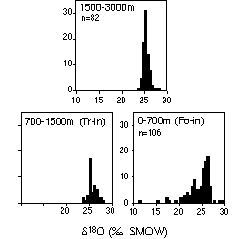
Quantitative analysis of aureole-wide fluid infiltration using stable isotopes is difficult due to heterogeneity in the amounts of observed isotopic alteration. This scatter is interpreted to be the result of focused fluid flow within aureoles. The aim of this study is to use statistically-based sampling methods to provide a data set which is both unbiased and large enough to be representative of an aureole. Carbon and oxygen isotopes were used as tracers of fluid infiltration in siliceous dolomites contact metamorphosed by the Ubehebe Peak quartz monzonite. Numerous mineral textures, the presence of skarns and veins, and the absence of a diopside zone in these silica-rich dolomites require infiltration of a water-rich fluid.
Over 230 samples of dolomites were collected in two different groups. The first group was collected without regard to mineralogy on an aureole-wide scale to provide broad coverage across the entire aureole. The second group was collected on a systematic grid at different locations in the aureole. Systematic sampling was done by placing a 50 centimeter grid on an outcrop and collecting samples at
pre-selected grid points. This grid was then moved approximately 5 meters perpendicular and/or parallel to the
sedimentary layering. Each sample was analyzed for bulk carbonate oxygen and carbon isotopic ratios.
The unmetamorphosed samples have a narrow range of isotopic ratios with values of d18O (”SMOW) and d13C (”PDB) of 25.2” ± 1.1 (2s) and -0.8” ± 1.0, respectively. Bulk carbonate values of d18O (”SMOW) and d13C (”PDB) for most of the aureole-wide data also show a relatively narrow range of d18O from 26.0 to 28.0” and d13C from -0.5 to 0.5”, even close to the contact. However, some samples have been shifted to values as low as 11.1” (d18O) and -9.1” (d13C). Figure 1 shows histograms of the data grouped by metamorphic zones. The unmetamorphosed and tremolite zone data show a relatively narrow distribution around 25”. While many of the samples in the forsterite zone have been shifted most still retain the sedimentary value. Values of d18O were also obtained for igneous hornblende (6.8”), clinopyroxene (6.6”), magnetite (2.7”), titanite (6.2”) and feldspar (8.7”). Their fractionation yields a concordant temperature of 670°C. The igneous d18O value of the feldspar shows no evidence of interaction with meteoric fluid, thus the likely source of infiltration is magmatic fluid. To evaluate the effect this infiltration, isotopic shifts due to devolatilization must be taken into account. A sample is considered infiltratively altered only if its isotopic shift is greater than that predicted by Rayleigh distillation models. The cumulative number of infiltratively altered samples increases as a function of distance from the intrusion. However, beyond 700 meters no more infiltratively altered samples are observed. This is the maximum extent of infiltration for isotopically reactive fluids. Within this 700 meter zone the percent of samples altered remains relatively constant at 30% (oxygen) and 20% (carbon). With this information, the amount of carbon and oxygen necessary to produce the observed alteration can be estimated using the average isotopic composition of the infiltrated samples. These calculations yield an estimate for the fluid composition of XCO2 =0.25 (assuming a binary H2O-CO2 fluid) and an overall volumetric fluid-rock ratio of 0.2 for the 700 meter altered zone. 
Fig. 1: Histograms of oxygen isotope data grouped according to metamorphic zone. The unmetamorphosed and tremolite zone data are tightly clustered around 25”. Samples in the forsterite zone have been shifted to lower values, but most still retain the sedimentary signature.